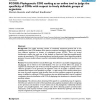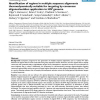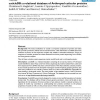BMCBI
2004
13 years 11 months ago
2004
Background: Recent genomic and bioinformatic advances have motivated the development of numerous network models intending to describe graphs of biological, technological, and soci...
BMCBI
2004
13 years 11 months ago
2004
Background: Genomic islands can be observed in many microbial genomes. These stretches of DNA have a conspicuous composition with regard to sequence or encoded functions. Genomic ...
BMCBI
2004
13 years 11 months ago
2004
Background: Kernel-based learning algorithms are among the most advanced machine learning methods and have been successfully applied to a variety of sequence classification tasks ...
BMCBI
2004
13 years 11 months ago
2004
Background: The rapidly increasing number of completely sequenced genomes led to the establishment of the COG-database which, based on sequence homologies, assigns similar protein...
BMCBI
2004
13 years 11 months ago
2004
Background: Computer programs for the generation of multiple sequence alignments such as "Clustal W" allow detection of regions that are most conserved among many sequen...
BMCBI
2004
13 years 11 months ago
2004
Background: Microarray data must be normalized because they suffer from multiple biases. We have identified a source of spatial experimental variability that significantly affects...
BMCBI
2004
13 years 11 months ago
2004
Background: A key step in the analysis of microarray expression profiling data is the identification of genes that display statistically significant changes in expression signals ...
BMCBI
2004
13 years 11 months ago
2004
Background: The function of a novel gene product is typically predicted by transitive assignment of annotation from similar sequences. We describe a novel method, GOtcha, for pred...
BMCBI
2004
13 years 11 months ago
2004
Background: Many current gene prediction methods use only one model to represent proteincoding regions in a genome, and so are less likely to predict the location of genes that ha...
BMCBI
2004
13 years 11 months ago
2004
Background: The insect exoskeleton or cuticle is a bi-partite composite of proteins and chitin that provides protective, skeletal and structural functions. Little information is a...



